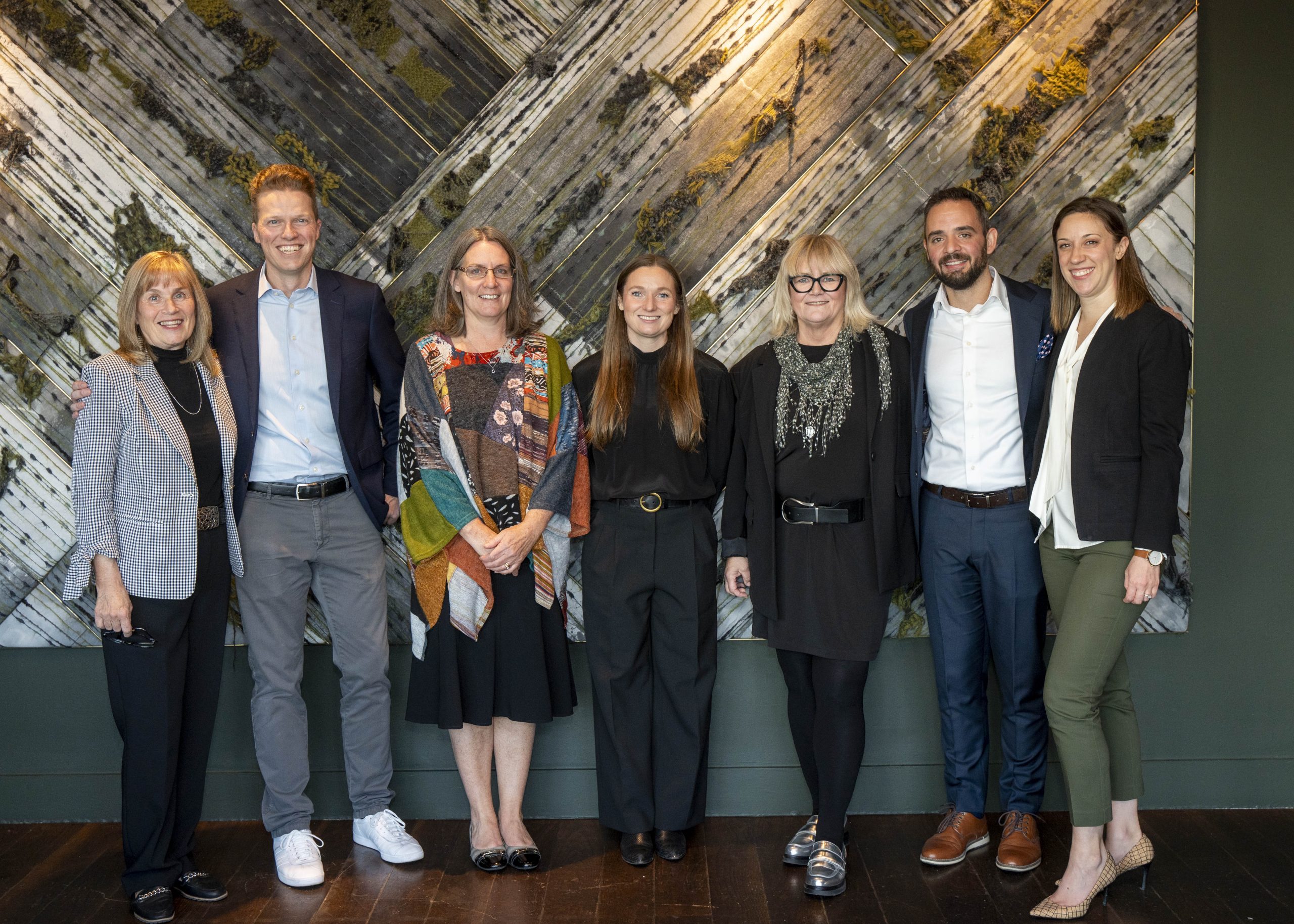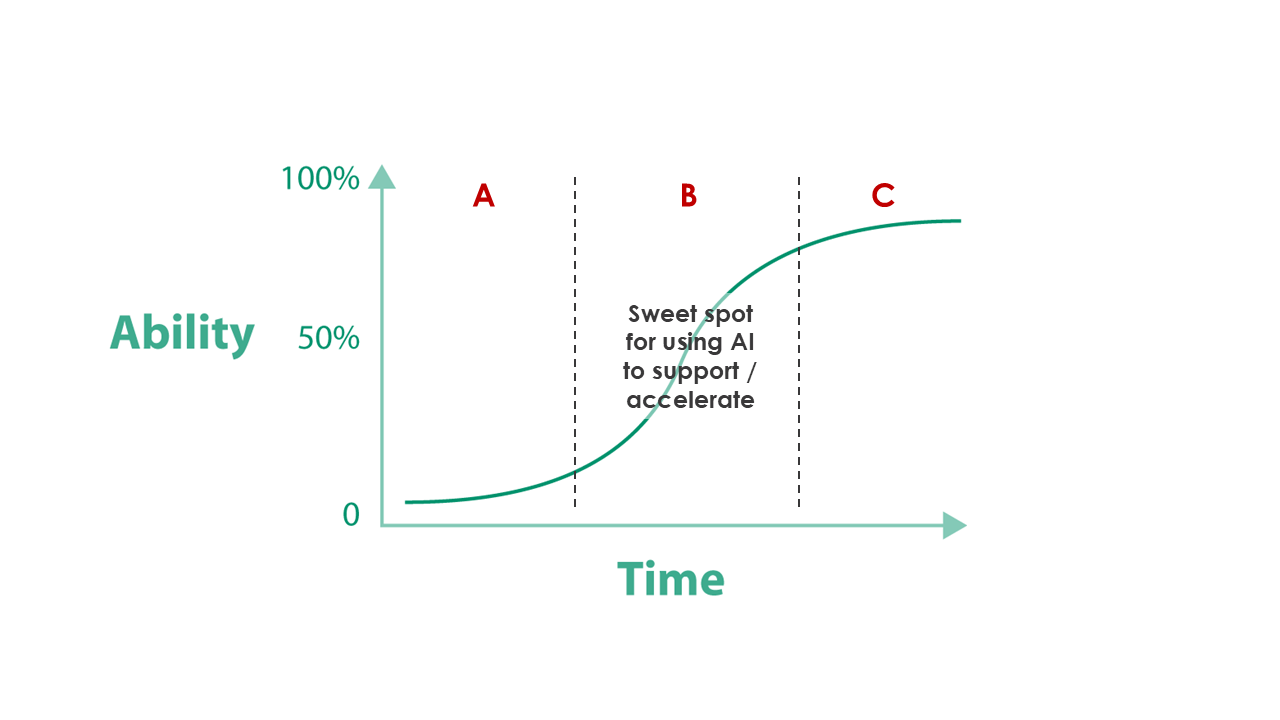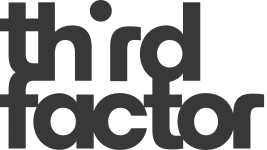 Here are three lessons from Rosie’s talk that can help anyone striving for their own version of a gold-medal performance.
Here are three lessons from Rosie’s talk that can help anyone striving for their own version of a gold-medal performance.
1: Confront failure head-on
One of Rosie’s most interesting insights was slightly counter-intuitive: when the fear of failure is strong, don’t shy away from it – lean into it. Ahead of the Olympics, Rosie consciously worked to confront the possibility of failure directly, and work through her worst-case scenario in vivid detail.“By confronting the possibility of failure, you can free yourself from its grip.”In partnership with her mental performance coach, Rosie sat down and played out two scenarios: what if things go well and I win? And, what if I stumble and fail? With these two scenarios in mind, she vividly worked through how she would feel and what her life would be like: 1 day after, 1 week after, 1 month after, 1 year after, and, eventually, 5 years post-Olympics. Rosie’s realization? Ultimately, the outcome at the Games would have little impact on her life 5 years down the road. Regardless of the outcome she would be okay. This mental exercise allowed Rosie to remove the distraction of fear from her preparation. By confronting failure head-on, she could redirect her energy from worrying about what could go wrong to focusing on what she could control. Whether you’re preparing for a major presentation, launching a new business venture, or pursuing a personal goal – instead of trying to avoid thinking about failure, take the time to visualize the negative scenario. When we “play out the full movie” what we often find is that the fear comes from the fact that we are just imagining a moment in time – an incomplete thought or image that doesn’t reflect the fullness of time. By confronting the possibility of failure, you can free yourself from its grip and focus entirely on performing at your best.
2: Embrace direct feedback
Rosie’s coach, Dave Ross, is known for a style that is extremely candid. While some athletes balked at his bluntness, Rosie saw something deeper: a genuine commitment to helping her succeed. She understood that behind his straightforward critiques was a profound belief in her potential. Instead of resisting his feedback, she consciously worked to lean into it, using it as information to unlock higher levels of performance. This ability to harness the value in blunt feedback came from her taking the time to understand Dave as a person. She took the time to look beyond personality and style to understand his values and ultimately his character. These insights didn’t just unlock her own performance, they also allowed her to help other athletes shift their perspective on Dave’s feedback by sharing her insights into what was behind his style. When you find yourself chafing at direct feedback, consider the intent of the person delivering it. Where are they coming from? What are they trying to help you accomplish? Often, others are trying to help – even when their wording or approach might trigger some reactivity.3: Use visualization to overcome obstacles
In the lead-up to the Tokyo Olympics, Rosie faced a daunting challenge: a series of serious ankle injuries that left her unable to perform her trampoline routine for weeks. In fact, she was unable to practice her full routine until one day before leaving for the Games.“When we imagine something with enough vivid detail – to our body, it’s real.”Rather than letting this setback derail her preparation, Rosie turned to the power of imagery and visualization. Unable to train physically, she trained mentally. This started with simply imagining herself bouncing on the trampoline again. She shared that, initially after the injury, every time she would close her eyes and visualize jumping on the trampoline – she would see herself falling. With effort and (mental) practice, she was able to start to imagine herself jumping with confidence, and eventually to visualize her entire routine in vivid detail. Remarkably, Rosie finished 4th at the Tokyo Olympics— less than a single point off of the podium featuring the best athletes on the world, all of whom had been training regularly, despite having been unable to physically practice until a single day prior to travel. When we imagine something with enough vivid detail – to our body, it’s real. Some studies estimate that for elite athletes, mental rehearsal delivers roughly 85% of the benefits of physical rehearsal. Rosie’s experience certainly backs up that research. Visualization isn’t just for elite athletes. It’s a tool anyone can use to prepare for high-stakes situations —whether it’s a speech, negotiation, or exam—spend time visualizing your performance. Imagine every detail: the environment, your actions, and the desired outcome. This mental preparation can help you feel more confident and prepared when the moment arrives.
Bringing it all together
Rosie MacLennan’s journey to Olympic success is more than a story about athletic achievement. Her approach to confronting failure, embracing feedback, and harnessing the power of visualization provides lessons that can help all of us. Here’s a challenge: think about your own version of a “gold medal performance.” What are you striving for in your career, relationships, or personal growth? Now, consider how you can apply Rosie’s three strategies: Confront failure head-on: What’s holding you back? Imagine the worst-case scenario to start to rob it of its power. Embrace direct feedback: Who in your life is pushing you to be better? How can you listen with an open mind and use their insights to grow? Use visualization to your advantage: What mental rehearsals can you do to prepare for your big moment? Coaching is, at its core, a deeply human endeavor. It’s a skill that requires empathy, curiosity, and an ability to connect with others on a personal level. Effective coaching demands patience, insight, and adaptability, making it a uniquely human process. Yet, as artificial intelligence (AI) tools like Copilot and ChatGPT become increasingly advanced and widely used, the potential to integrate AI into the coaching process is becoming more apparent. Rather than viewing AI as a replacement for human coaches, we see it as a complement—a tool to augment the learning experience and extend the reach of coaching. Our approach, inspired by our company’s founder Dr. Peter Jensen, is rooted in the idea of AI as “the coach’s coach.” Instead of attempting to replicate the nuanced human interactions of coaching, we’re leveraging AI to sustain learning and assist leaders as they progress toward coaching mastery. AI becomes a tool that helps leaders get comfortable with coaching and sharpens their skills, rather than replacing the critical role of a human coach.Drawing inspiration from “The Coach’s Coach”
Dr. Peter Jensen has been known for decades as “the coach’s coach.” Over 35 years, his focus has been on empowering coaches rather than stepping into their shoes. He works to help them improve their craft and support their teams more effectively, offering guidance, insights, and tools to help them reach their potential. His role isn’t to be the head coach, but instead to act as a mentor and resource for those who are. This philosophy guided us as we considered the potential of AI in leadership and coaching development. What if every leader had access to an AI-powered coach in their pocket—one they could turn to for advice, guidance, and practice whenever they needed it? This vision drives our integration of AI as a tool that complements and supports, rather than competes with, human coaches.Understanding AI’s role in the learning curve
The learning curve is a familiar concept in skill development. It illustrates how people acquire new skills over time, beginning with an initial uncomfortable phase of struggle and slow gains, progressing through steady improvement, and then hitting the final grueling ascent to achieve true mastery. AI’s role is most valuable in the intermediate stages, where learners have built a foundation and consistent practice and support can help them to make big leaps up the curve.
High touch to learn
At the beginning of the learning curve, learners are stepping into unfamiliar territory, and progress can be slow and frustrating. At this stage, motivation, encouragement, and a safe environment to make mistakes are critical. This is where the presence of a human coach is indispensable. Human interaction provides the emotional support and expert guidance that learners need to build confidence and take those first steps.“The goal of this high-touch phase is to equip learners with a solid foundation and prepare them to apply their new skills independently.”For example, in our 3×4 Coaching program, leaders regularly report discomfort with delivering corrective feedback and therefore delay or outright avoid it. In the classroom, we are able to set them up in pods with their peers and, through a triad exercise, show that giving “negative” feedback can be a positive, developmental experience. With the encouragement (and accountability) of their peers, participants take the first steps up the learning curve and start to build confidence. This is not much different than learning to ride a bicycle. Initially, the learner needs someone to hold the bike steady, provide feedback, and offer reassurance. This hands-on support is essential for achieving balance and overcoming the fear of falling. Similarly, in leadership development, learners benefit greatly from in-person workshops or coaching sessions where they can practice new skills, ask questions, and receive real-time feedback. The goal of this high-touch phase is to equip learners with a solid foundation and prepare them to apply their new skills independently.
High tech to transfer
As learners move past the initial hurdles, they enter the middle phase of the learning curve. This is the growth phase, where they’ve gained a basic understanding but need consistent practice to refine their skills and build confidence. At this stage, AI can play a crucial role in supporting learners’ development. AI tools excel at providing scalable, consistent support during this phase. They can simulate real-world scenarios, offer constructive feedback, and serve as a resource for learners to practice and refine their skills. Our pilot programs have confirmed the value of this approach. Leaders who have used our AI tools report that these tools help them apply what they’ve learned in their training programs. For example, our AI tools have been instrumental in helping leaders simulate coaching conversations, deliver feedback effectively, and prepare for performance reviews. By practicing in a non-judgemental, low-stakes environment, they gain confidence and improve their skills before applying them in real-world situations.AI as sustainment
AI is particularly effective at supporting sustainment. To understand this, it’s helpful to distinguish between two types of motivation in the learning process: the motivation to learn and the motivation to transfer.“People are motivated to learn when they encounter new ideas, engaging experiences, or compelling stories.”The motivation to learn is rooted in intellectual curiosity. People are motivated to learn when they encounter new ideas, engaging experiences, or compelling stories. This type of motivation often requires a human touch—someone who can inspire and captivate learners, sparking their interest in the subject matter. These are areas where human coaches excel. They can create dynamic, interactive learning experiences that draw learners in and motivate them to engage with new concepts. The motivation to transfer, on the other hand, is about applying what has been learned in a real-world context. This requires an environment where learners feel supported and confident in their ability to succeed. Motivation to transfer comes from having access to resources, someone to turn to for advice, and a sense of accountability. These are areas where AI shines. By providing tools and guidance for application, AI helps learners bridge the gap between theory and practice. AI can simulate coaching conversations, offer tailored feedback, and provide reminders to keep learners accountable to their goals. It creates an environment where learners can experiment, refine their skills, and build confidence in their abilities—all while supporting their long-term growth.
The future of coaching
The integration of AI into coaching enhances rather than replaces the role of human coaches. While human coaches inspire curiosity, build foundational skills, and connect on a personal level, AI excels at providing scalable, consistent support during the critical growth phase of skill development. This complementary relationship allows learners to benefit from both personalized guidance and accessible tools for practice and refinement. By blending the strengths of human connection and technological capability, we create a sustainable, accessible coaching model. Human coaches can focus on motivation and expertise, while AI supports learners in applying and mastering new skills. This balanced approach ensures coaching remains effective and widely available, fostering a culture where both learners and coaches thrive in an evolving landscape. Over the past year I have worked with hundreds of leaders across a range of industries. And the most common question they have asked is “How do I sustain the energy levels of my people?”. This year, more than any other in recent memory, has taxed the energy reserves of even the most resilient teams. Hugely disruptive changes, prolonged periods of uncertainty and the blurring of work and home have drained people’s batteries and made it difficult to recharge. When leaders try to step in and fill the energy gap, it’s not long before they find themselves starting to run out of gas. The key is to take on the challenge, without trying to do it all on your own.A team’s energy comes from within
A while back I was leading a Self-Aware Team program for the coaches and support staff of a team that was preparing to represent Canada at the Winter Games in Beijing. An important part the program is an exercise in which team members create “player cards” containing key insights they’ve learned about themselves through the program. The group then comes together in a Zoom call to share those insights and give and get feedback. Like so many others, this group had been through an incredibly taxing year. Because of the pandemic, the team had to expend significantly more energy than it ordinarily would to create effective training opportunities for the athletes. Quarantines and “bubbling” rules had forced individuals to spend months at a time on the road, adapting to new routines and away from their families. And uncertainty over everything from health and testing to the potential fate of the games loomed over it all.“The ways they brought energy were as diverse as the people themselves.”As the group shared their player cards, it quickly came to light that a number of different members of this team had been significant “energy givers” through this difficult time. And the ways they brought energy were as diverse as the people themselves.
- One senior leader on the team created energy in the more traditional way that many leaders do: by envisioning a compelling opportunity, mapping out a plan to get there and leading the charge towards it.
- Another team member helped bring lightness to the daily grind by noticing and pointing out funny moments, breathtaking views, or interesting aspects of their surroundings. These moments created mini-breaks that relieved tension and reminded the team of the unique and special journey they were on together.
- Another contributor was celebrated for their “can-do attitude.” This individual had a “big personality” with a healthy dose of confidence who led by example and encouragement. Their jokes, positive energy and infectious smile helped the team forge ahead with a belief that they could prevail when they were hit with a setback or success seemed a long way off.
- Yet another had taken on the role of a confidante and created a safe, non-judgmental space for people to bounce ideas, vent frustrations and seek advice when they needed to gain perspective on a situation (or person) that was creating challenges.
Three energizing principles
In listening to the group share their feedback, I was struck by three things: Energy is found in diversity. During the discussion I heard multiple different ways that multiple different people infused the group with energy. Some provided big boosts, other provided steady nudges. Some energized all team members. Others were more critical in sustaining a handful of specific individuals. Some were helpful at the start to get the flywheel moving forward. Others stepped in during negative moments to break tension and redirect focus when forward movement was stalled. Each team member’s contribution could stand on its own, but put together they added up to more than the sum of their parts. Energizing the team is everyone’s responsibility. No single contributor can create enough energy on their own to sustain a team; the demands are simply too vast. Everyone on the team shares some responsibility for energizing their teammates. The team leader’s job is to create the conditions that allow it to happen. Feedback is of key importance. In many cases, the “energy givers” were surprised to learn the value of what they provided. In fact, some had mistakenly believed that the very behaviors that others found energizing were irrelevant or a distraction. If not for the reinforcement they received during the session, many had been planning to curtail some of those behaviors moving forward. And, if that had taken place, then valuable sources of positive energy would have simply faded away because people were unaware.Energize your team
Every leader needs to create an environment that enables their people to perform. And energy is a critical part of that environment. But it’s not the leader’s role to provide that energy all on their own. Instead, the best leaders create the conditions for “energy givers” to thrive.“Create a clear image of what it looks like to be an energy giver.”Start by setting the expectation that energy is a team responsibility. Work with your people to create a clear image of what it looks like to be an “energy giver” and what behaviors will move the team’s energy level in a positive direction. Help your team surface the different ways “energy givers” sustain the team in tough moments. Make it a part of your regular check-ins to ask people what’s contributed to their energy over the past week and encourage open discussion when appropriate. Finally, provide opportunities for regular feedback and recognition so that each “energy giver” knows what to keep doing. This feedback can come from you as a leader, but people should also hear from their peers. Effective feedback recognizes the behavior, communicates its impact, and encourages the person to continue. With this approach, a leader can create more energy on their team than they could ever hope to do alone, while at the same time helping their people to stay engaged and motivated through whatever may come. Over the course of your career, you’ve probably handed out a few “feedback sandwiches” – a piece of criticism hidden between two pieces of positive reinforcement. But as Peggy Baumgartner lays out in her latest article for HBR, you need to stop softening tough feedback. In the article, Peggy outlines why the “sandwich” doesn’t work:
🧹 People who think highly of themselves might brush off the piece of corrective feedback, giving more weight to the positive news surrounding it.
😟 But those who are self-critical might dwell on the bad news and miss out on the good.
🐍 And the lack of direct communication makes people feel like they’re victims of a sneak attack.
Instead, Peggy offers simple advice for leaders who need to give feedback: Describe the behaviour you want to reinforce or correct, explain the impact of the behaviour, and outline what you want them to do. Click here to read the article on hbr.org. In our 3×4 Coaching virtual learning journey, participants are given challenges to apply what they’ve learned on the job. In this video, our Chief Learning Officer, Peggy Baumgartner, showcases how one program participant used a challenge activity to make a lasting difference in his organization. When it comes to coaching, it’s not about what you know; it’s what you do that ultimately matters. That’s why we make challenge activities a part of our online learning journeys. Participants are given a challenge and encouraged to make note of what works for them and what impact it had. One participant, taking the 3×4 Coaching program through Queen’s Executive Education, really took his challenge on recognition to heart. Following the challenge, Dave Cooper shared that he had written a letter to his team to recognize their contributions through the pandemic. As the manager of retail leadership development for Sport Chek, a major retailer with approximately 250 stores, his team had been hard hit by the Covid-19 pandemic. “Our training team got very disconnected from the stores, which was really difficult for me personally and difficult for our team,” Dave told us. “After going through eight months of this constant stress, I wanted to see if I could write something to recognize what they’d accomplished how long they had endured. And maybe give them a little nudge that they have more in them.” Dave’s letter to his team was particularly effective because it took all the key concepts from the recognition module and used them in a very powerful way:- Make it relevant. Dave’s first success was in his timing. Rather than waiting until everything had settled down, he took the time to recognize his people in the moment and let them know they were seen.
- Focus on the behavior, not results. In the letter, Dave recognized his people not for the results, but for their efforts. “You and your team have persevered well over 200 days,” the letter reads. “This is an incredible achievement!”
- Make it a habit. Dave told us that he didn’t want it to be a one-time thing. Rather than writing a letter to his team and calling it job done, he set reminders in his calendar for future times he know would be busy to remind himself to recognize his team.
- Extend influence & ownership to others. The impact of Dave’s letter didn’t stop at his direct reports. He challenged them to pay it forward: “thank your management teams, your full-timers, your part-timers and anyone else who has contributed to your store’s success,” he wrote. “Everyone plays a role!”
“Let me give you some feedback on that.”“Then use a verbal yellow highlighter,” I responded. “Whenever I have to give anybody feedback, and I want to to make sure it’s been heard and recognized as feedback, I always use the word feedback and emphasize it… as in ‘let me give you some feedback on that.’” On the next day of the program she walked up to me and said “Oh my gosh that was so simple, and it will make a big difference. In thinking back to my conversations with my employees I realized that very often when I was actually giving them some feedback I rarely used the word feedback, so they didn’t recognize it as such when they were asked.” It will definitely help the employees’ performance and, secondarily the results on her 360 feedback.

